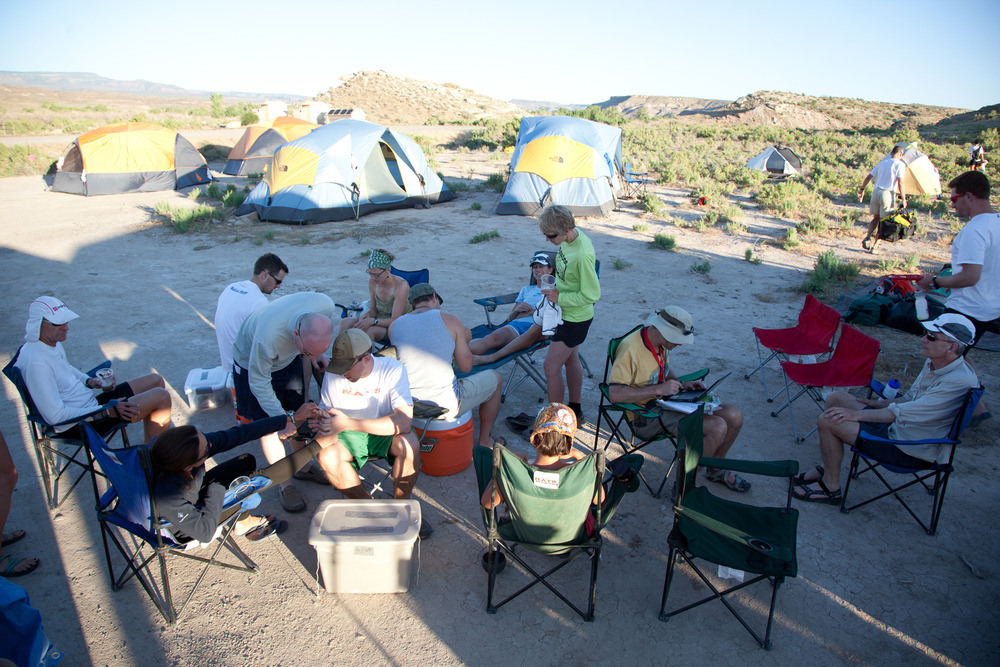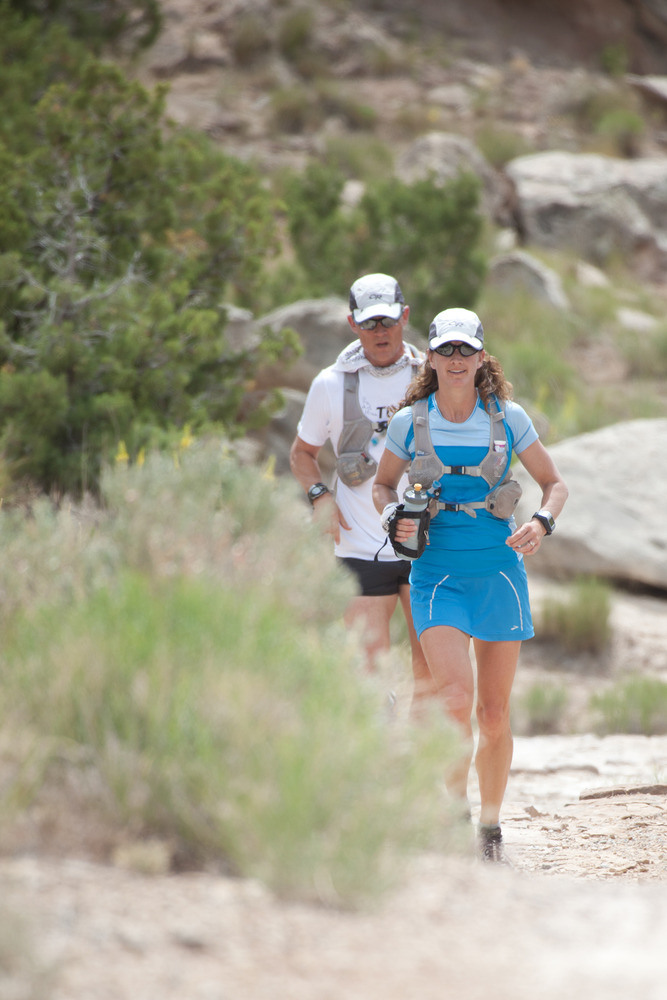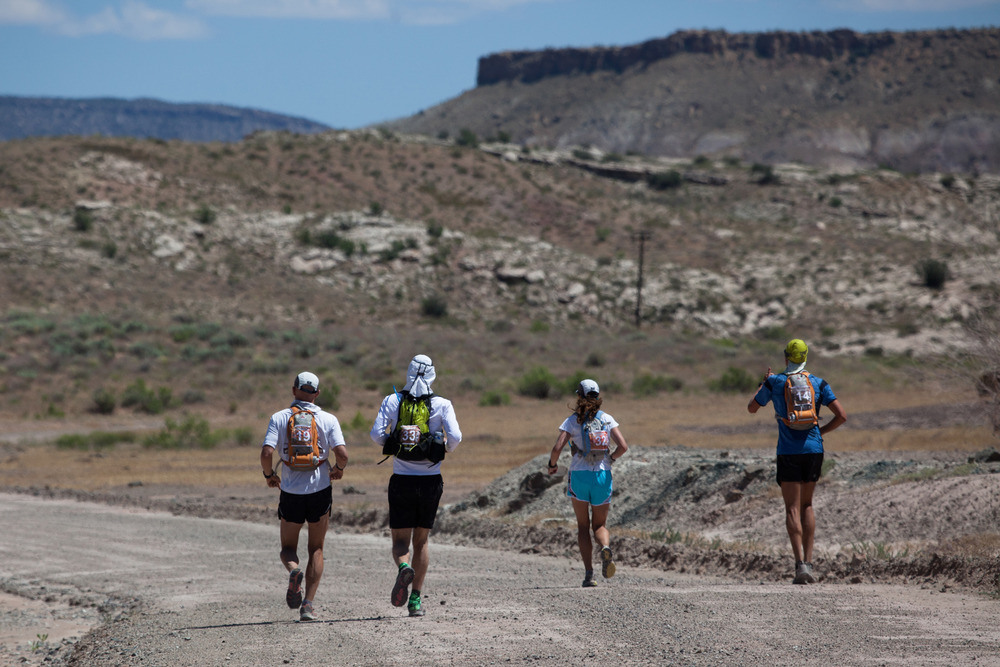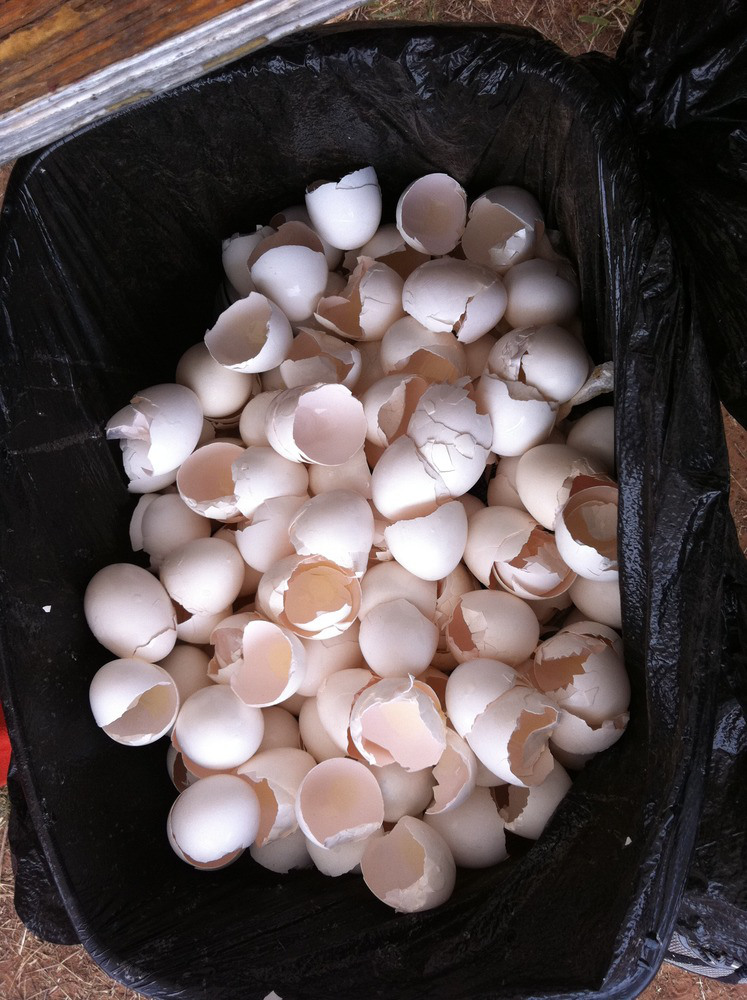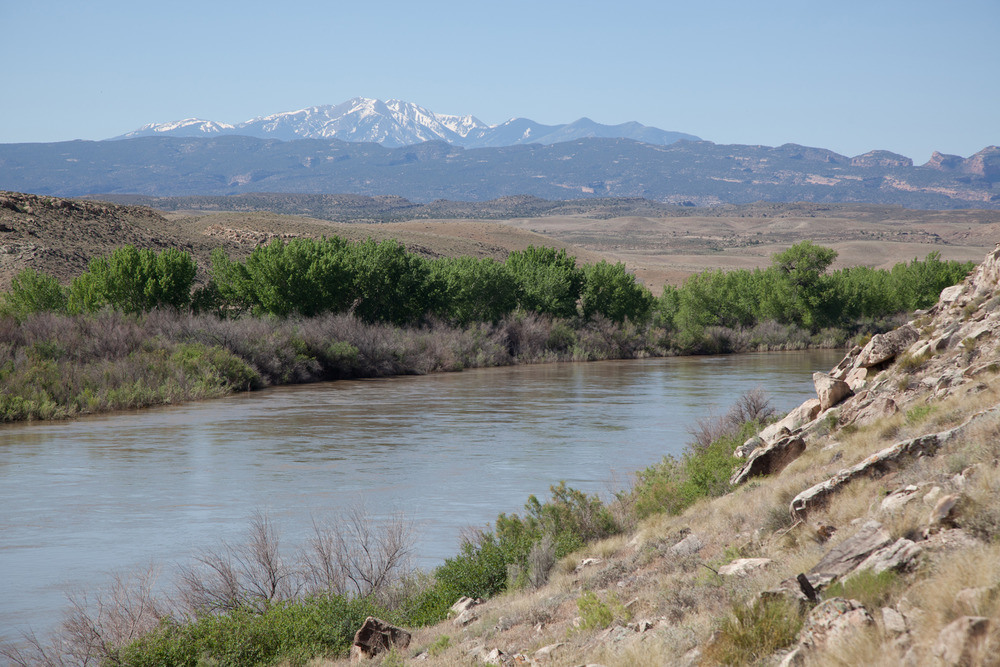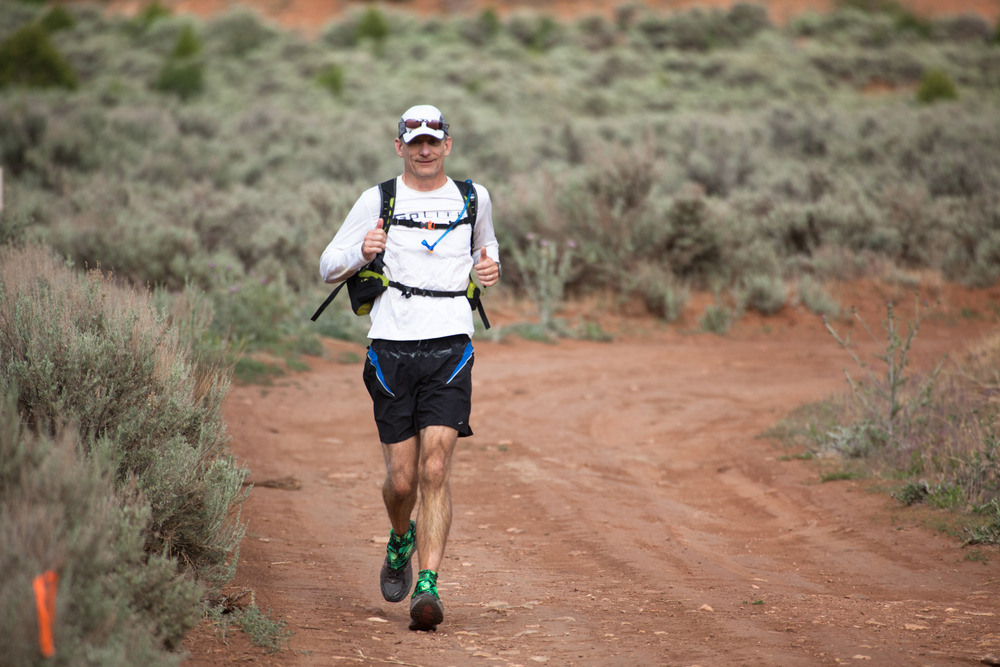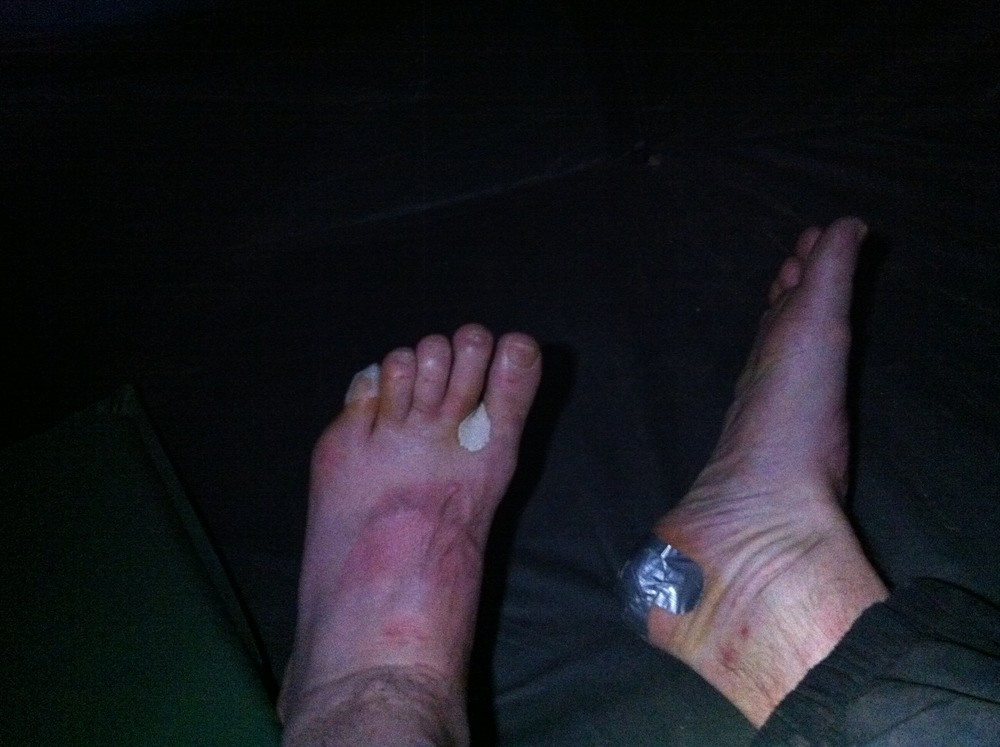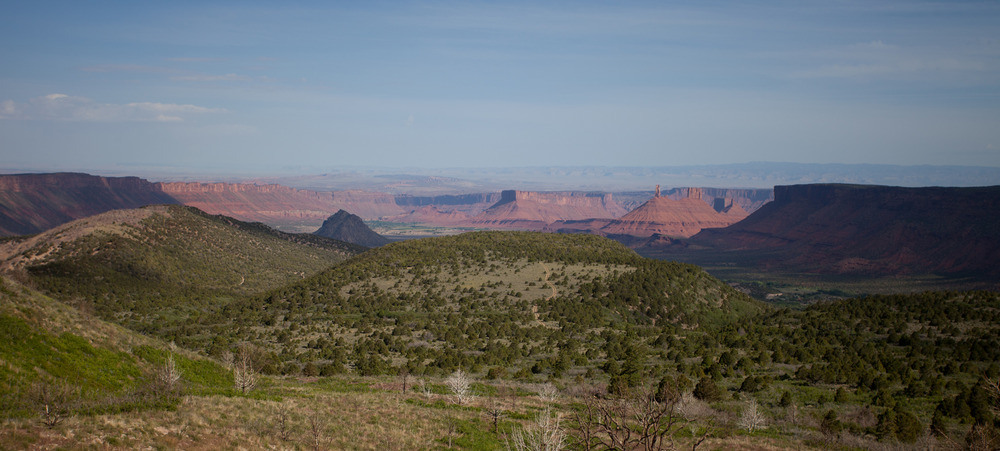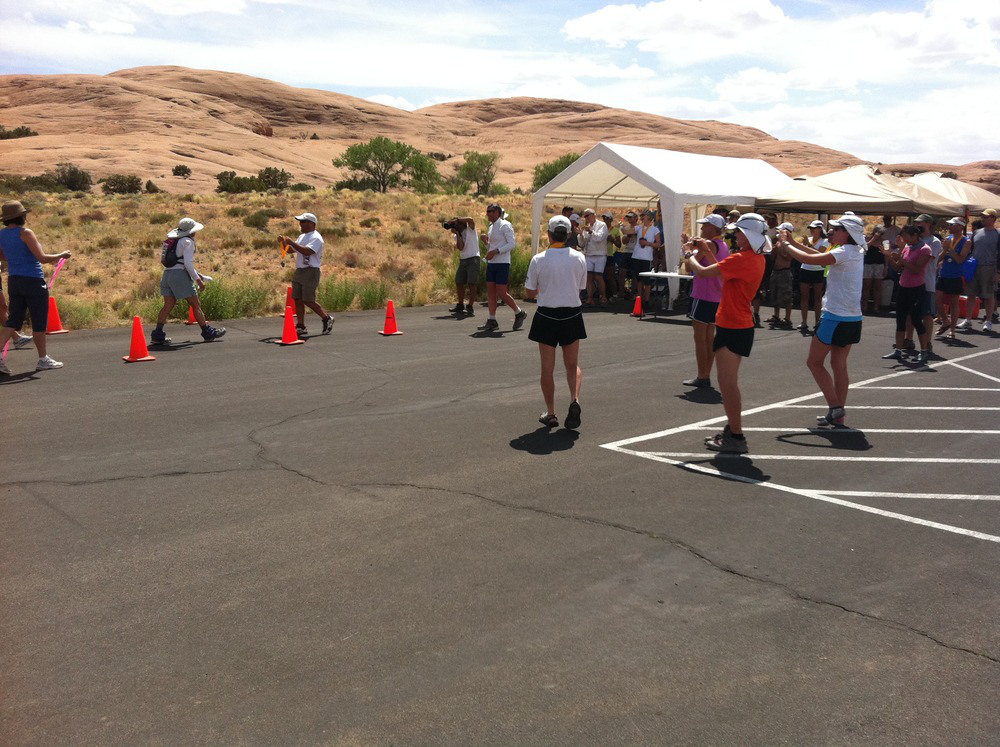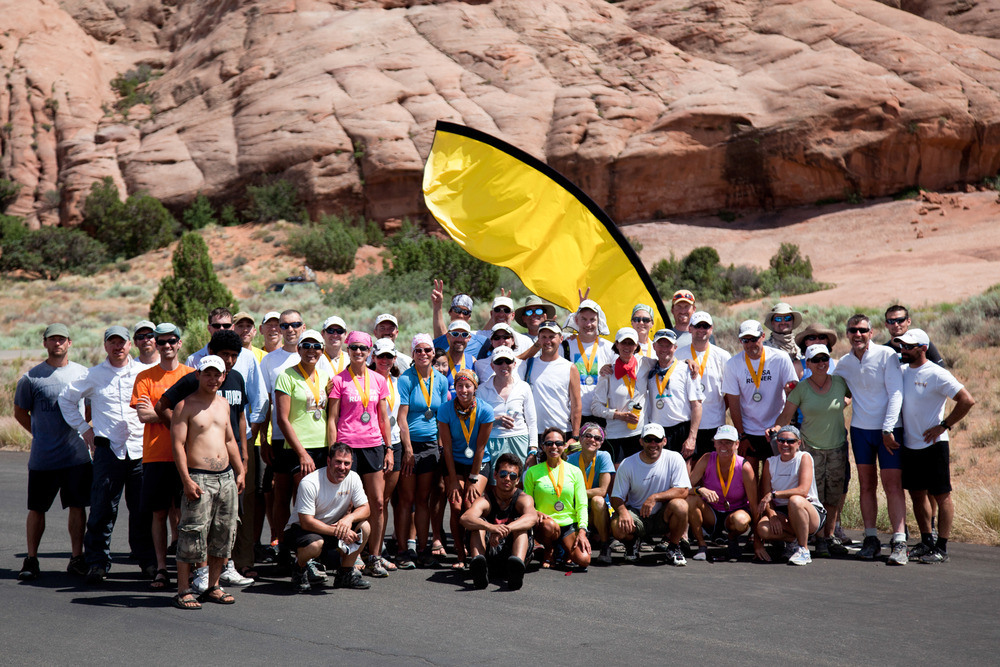Back in November of 2010, I read a short race report about a six day, stage running race – 148 miles across the Colorado and Utah desert on foot. My imagination was hooked, and eight months later I found myself on a bus with 31 other racers, driving away from Moab, UT, on our way to the starting line nearly 150 miles away. The bus stopped at a trailhead, we got out, and after some brief encouragement from the race director, we began our trek back to Moab, along the Kokopelli trail.
Day 1 was actually one of the shorter days, “only” 20 miles. But starting in the midafternoon meant that we experienced the heat and wind of the day. I was struck by the beauty majesty of the surroundings. I’m used to trees and flowers, so it was hard for me to see the beauty that first day, where rocks, scrub brush, rocks, and more rocks were our steady diet for hours. But the majesty of the canyons and buttes is plain to see – and everywhere in this part of the desert. My run went well on that first day, but I grossly underestimated my fluid needs. I ended the day severely dehydrated, and after finishing spent upwards of half an hour on my back with my feet elevated trying to get my blood pressure stabilized and my fluid levels settled.
During this time I was watched over by an outstanding medical team. There were four docs who travelled with us – some were ER docs, some with military combat medicine experience, and all of them visibly committed to making our run a success. Each night, the medical team would set up a “blister clinic”, and treat all comers – draining blisters, and taping feet and toes for the next stage. I’m glad that on the whole, their week was uneventful. But they were a great asset to the race, made us feel more secure, and were great guys as well.
Photo: Glen Delman
Blister Clinic
Before the race, I considered Day 2 the most difficult, and it did not disappoint. Since we started Day 1 so late in the day, we didn’t have much recovery time between these stages. It also traditionally was the warmest stage. Due to recent flooding of the Colorado River, our planned camping area at the end of Day 2 had to be moved, so our mileage for the day was shorter than planned, around 35 miles. I spent much of this day (and many of the others) running with Kurt and Shelley Egli. They had run RATS twice before, and were a wealth of knowledge and experience. Kurt was my “desert whisperer” – throughout the week he would quietly inform me of some nugget of info about the heat, the course for the day, or the week ahead. Shelley taught me that I have a whole other gear with which I can climb hills!
Photo: Glen Delman
Somewhere near the middle of the day we met up with Jason McGinniss – who had been way out in front of us up until then. Jason had taken a wrong turn, and had burned a fair bit of time and energy before getting back on the course. The four of us ran/walked for what seemed like hours.
Photo: Glen Delman
Jason, Shelley, Kurt and me
Much of the second half of the day was on one LONG, relatively straight “road”, so someone would pick a landmark (typically a telephone pole), and we’d run to that. Then walk to the next pole, and then we would run to the next landmark. Repeat. And again. Do that 30 more times. And that was Day 2 in the books. I spent much more mental effort on drinking a LOT of fluid, and keeping my electrolytes topped off – so thankfully I had no hydration/energy/GI problems at all.
Each day the wonderful camp crew would tear down camp as we ran, and when we arrived at the day’s finish line, miraculously we arrived at a fully assembled camp. Food was plentiful and very tasty. And I’m not sure how many watermelons gave their lives during the week, but I’m guessing it was somewhere north of 100.
Starting on Day 2, each of our camps was close enough to the Colorado river to allow us to soak our legs, and take a QUICK dip – the water was very recent snow melt, and was probably in the mid 50s. But it felt soooooooooo good on the legs, and it was nice to get at least the top layer or two of dirt off.
For Day 3, we ran a little longer than expected, to make up for some of the lost distance the prior day, the consensus was that it was around 11.5 or so. The joke around camp was that: “It’s an unusual group of people who consider an 11 mile run a ‘rest’ day”. I ran with the Egli’s again, and Doone and Tim Watson – a delightful couple (of fearsome runners!) from Canada. Well, I ran with that crowd until the mud. We had been warned about the mud that the receding river had left on the trail – and nobody had any trouble…except me. My very first step into the mud resulted in my shoe and gaitor being sucked right off my foot!! I was glad there was a big rock there, so I sat down and put myself back together again. And tied my shoes a little tighter this time. Maybe too tight…
Day 4 – the Expedition Stage – 52 miles, up and over a mountain range, and back down the other side.
Photo: Glen Delman
One of the challenges of Desert RATS is staying on the right trail. During this stage, at least two people got off course long enough to end their race. I felt so bad for those folks. And I was very nearly one of them myself. I was running with the Watsons through a nice area, and had drifted ahead on a long downhill section. Cruising through a trail intersection, I realized I hadn’t looked carefully for a trail marker, and went back. I found the marker, but in my haste I looked at it from the wrong side (so no matter what, I wasn’t seeing the correct arrow), and then I must have not even read the marker correctly, and started off on the side trail, uphill, full speed ahead. Doone and Tim arrived at the crossing shortly afterwards and saw me blundering up the wrong trail, and called me back. A minute later and I would have crested the hill, and they wouldn’t have seen me…and I have no idea what would have happened. I was very low on water at that stage, and we were literally, out in the outskirts of nowhere’s-ville. I told them that when I get home I was going to have another set of twins, just so I could name them “Tim” and “Doone”.
Thankfully, most of the rest of the Expedition Stage went off without a hitch. I was very disciplined to take a shot of nutrition – Infinit concentrate – each 15 minutes, an S-Cap each 20 minutes, and to wash them down with lots and lots of water. I was pee-ing about every hour and a half, and had no bloating. In one particularly long segment (11-12 miles) I drained my main Camelbak bladder (100oz) and my reserve bladder (35oz). I was NEVER so thankful to see a water drop!!!
With 7.5 miles to go, I hit the last aid station and was feeling very good. I realized that I would not be making my 12 hour goal for the day, which I really needed to hit in order to reach my 30 hour goal for the week. But the last 6 miles was downhill on pavement, so I was anticipating making up a bit of time. I got a refill on water, and had my mandatory equipment check. Each aid station, the crew would ask for one piece of mandatory gear – the knife, strobe light, mirror, etc., and mark it off in our expedition book, as well as recording our time. We exchanged well wishes, I took a step, and my knee exploded in pain. I could instantaneously tell that my IT band had siezed while I was standing there, and each step brought me to new levels of pain. I hobbled off, not wanting to get corralled by the med guys at the aid station, and got my pain induced hyperventilating under control. By walking with my leg straight, it didn’t hurt too bad, so I kept moving, and rubbing the outside of my leg to try to soften up the spasming tendon. After a while, my peg leg started to bend a bit, then a few test steps jogging, then I was back into it. Then, like a moron, I stopped to pee. I hadn’t pee’ed before the last aid station in case they were goint to weigh me (if I had lost too much weight, they could pull me off the course). Well, now it was time, so I went to the side of the road, and went. First step, and HELLO KNEE!!! Crap. Let’s try this again. Peg leg walking, massaging as much as I could, and it softened up enough to get going again.
I started the day by cruising the first 10 miles, and enjoyed some brilliant scenery and good company. But at hour 2, I really started to “race” in pursuit of the 12 hour goal, and my body and mind paid for it. I have never before focused so intently, and for so long, on moving forward. Working hard to tackle the uphills without losing too much time, and really pushing on the downhills – of which there were many, and many of them were quite technical. I got two new blisters this day to complement the little guy on my pinkie toe. I finished in 12:18, and was very happy with that result.
Photo: Glen Delman
Day 5 was a real rest day, no running, just soaking in the river, and eating. One of the best lines of the week was delivered this morning…from one of the tents I hear: “I feel like I got hit by the ugly truck. Then it backed up, and hit me again.” So true. We were all pretty beat up, and filthy, and I can’t imagine what the scent was like downwind. I got my feet taped up, and ready to go for the marathon on Saturday.
We also enjoyed a slide show of photos that Glen Delman had taken through the week (and he graciously allowed me to use some of them here). It was an emotional night, as we realized the magnitude of the adventure we had shared together, and the beauty we had started to see in the desert – and in our fellow racers and the crew.
Day 6 – let’s run a marathon! This stage starts with a monster up, and then a huge downhill, with a little slice of technical trail running on a 5 mile out and back spur.
Photo: Glen Delman
The view from the climb
Well, it WOULD have been only a marathon if I wasn’t a doofus. Going into the first aid station at the top of the huge hill, I let my companions drift ahead so that I could go into the station a bit slower, but spend less time there. I was very concerned that my knee would flare up again, so I wasn’t taking any chances. I left the aid station and crested the hill, and my companions were already long gone – so I took off running down the hill at a really good pace…until the car came up next to me. One of the runners saw that I went right past the trailhead and screamed and whistled for me, but I never heard him. He got the attention of the aid station folks, and they sent a car after me. I was about .4 miles down the road when he told me I needed to turn around (and walk back up the hill – grrrrrrrrr).
With that, all hopes of a 30 hour final time evaporated, and I turned my attention to just running hard and doing the best I could. The technical out and back on Porcupine Rim was really hard for me – since it was out and back I was able to see how far ahead the other runners in my morning group were, but I just couldn’t summon the juice to close the gap. To my credit, I got “lost” again, but only got 3 yards down the trail and realized that I was maybe on the wrong trail. I started looking for tracks, and seeing none went back to the last “Y” and saw a bunch of tracks on the other trail. It only took 6 days, but I finally learned how to stay on the trail!!
The finish line was a raucus celebration. All the finishers clapped, shouted, and whistled for each runner as they rounded the last turn.
I was SOOOOOO happy to see the flags of the finish line, and to hear the screaming and banging of water jugs. I had finished Desert R.A.T.S., and the smile didn’t leave my face for four days. My final time was 30:18, which placed me as the 4th male, 5th overall. That one female was Suzanna Bon – a delightfully humble runner who demolished the women’s course record by five hours. We ran together for a while on Day 1, and after a while she politely said something like “I think I’m going to go on ahead” as I walked up a hill, and she ran it like a mountain goat.
Photo: Glen Delman
Epilogue – This race was something special. It was much more of an “event” than a running race. Reid Delman, the Race Director, and his crew, were incredibly generous with their time, efforts, and themselves, and made it possible for us to focus on running. In the days following the race, it became clear to me that the race had made a big impact on me. Here’s an excerpt from an email exchange I had with Jason McGinnis:
Me: I am having a A LOT of trouble getting focused and back to work this week – just feels like I should be somewhere else…
Jason: Yes, getting back to reality has been really tough for us too. The emails, the calls, work, traffic, rude people…it all sucks. The Tulsa crew has been calling it “post rats depression”. It makes me wonder if people might have been much happier hundreds and thousands of years ago. I think we lived for a brief while somewhat like nomadic native americans. A small tribe of ultrarunners, who instead of going out every morning and hunting for food, we went out and ran. Then we came back to camp and ate, relaxed, and slept. No bills, no taxes, no tv, no phones, no shopping malls, no government, just new relationships and a beautiful landscape. We washed our clothes by hand and bathed in sandy cold water. And somehow that is more satisfying to me than what we all go home too. I think through industrialization and technology the western world has lost something special very special. I can’t quite put my finger on what it is we have lost, but I think RATS gives us a glimpse of what life could be like. To me simpler is better. Also being surrounded by endurance athletes is awesome. Everyone there has tested themselves and pushed their bodies to extreme levels at some point in their lives. Everyone of us has experienced suffering and persevered through it and whether we talk about it or not it makes us different kinds of people than the rest of the modern world.
Me: I always think it funny when we “discover” a new tribe out in the middle of the Amazon or something, and we feel so happy that we can bring “civilization” to them – to free them from their horrible life in sync with the earth and their environment…but with out Nintendo (oh the terror!!)
I’m thinking that something we all experienced was “accepting” our environment. It was hot, and the hot wasn’t going to go away by bitching about it – so we didn’t bitch, and accepted the heat. And the climbs weren’t going away – they were something to be accepted and experienced, until they were gone, and a new challenge presented itself. For me, I didn’t fight the desert, and I think that greatly helped my race and my attitude. And it helped that camp wasn’t full of a bunch of drama queens/kings.
The first time I paced someone (very early in my ultra running career) the guy taught me “you have to get comfortable with being uncomfortable.” And maybe that’s the glue that joins RATS together – we’ve all made that adjustment to life, that discomfort isn’t something that MUST BE ELIMINATED at all costs, but rather, can be accepted, and maybe even enjoyed a bit.
Dang, awful philosophical for a Friday morning!!!
Jason: I think its nearly impossible to do something as awesome and challenging as RATS and not get philosophical or come away with a different perspective on life. And trying to explain all this to friends and family…forget about it.
Medical Epilogue – Remember when I pulled my shoe out of the mud and tied it real tight? Well, I’m thinking I did something bad to my foot that day. When I woke up the morning of the 52 mile stage, the top of one of my feet (right under where the knot was) was very sore – and it stayed sore throughout the day, and through the rest of the race. It’s a little over a week gone by now, and it still hurts. I’ve had it x-rayed, but nothing showed. I’ll go back again in a couple of days since stress fractures often don’t show up right way.
Another thing that happened in my first week back – I was VERY lethargic. After a couple of days I stepped on a scale, and saw that I was 5 pounds lighter than when I started the race. I then began “recovery eating” in earnest, and my energy returned very quickly.

